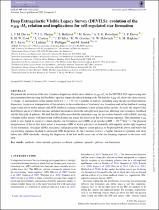| dc.identifier.citation | Davies, L.J.M., Thorne, J.E., Bellstedt, S., Bravo, M., Robotham, A.S.G., Driver, S.P., Cook, R.H.W., Cortese, L., D’silva, J., Grootes, M.W. and Holwerda, B.W., 2022. Deep Extragalactic VIsible Legacy Survey (DEVILS): evolution of the σSFR–M⋆ relation and implications for self-regulated star formation. Monthly Notices of the Royal Astronomical Society, 509(3), pp.4392-4410. | en_US |
| dc.description.abstract | We present the evolution of the star formation dispersion–stellar mass relation ( σSFR –M ) in the DEVILS D10 region using new measurements derived using the PROSPECT spectral energy distribution fitting code. We find that σSFR –M shows the characteristic ‘U-shape’ at intermediate stellar masses from 0.1 < z < 0.7 for a number of metrics, including using the deconvolved intrinsic dispersion. A physical interpretation of this relation is the combination of stochastic star formation and stellar feedback causing large scatter at low stellar masses and AGN feedback causing asymmetric scatter at high stellar masses. As such, the shape of this distribution and its evolution encodes detailed information about the astrophysical processes affecting star formation, feedback and the lifecycle of galaxies. We find that the stellar mass that the minimum σSFR occurs evolves linearly with redshift, moving to higher stellar masses with increasing lookback time and traces the turno v er in the star-forming sequence. This minimum σSFR point is also found to occur at a fixed specific star formation rate (sSFR) at all epochs (sSFR ∼10 −9.6 Gyr −1 ). The physical interpretation of this is that there exists a maximum sSFR at which galaxies can internally self-regulate on the tight sequence of star formation. At higher sSFRs, stochastic stellar processes begin to cause galaxies to be pushed both above and below the star-forming sequence leading to increased SFR dispersion. As the Universe evolves, a higher fraction of galaxies will drop below this sSFR threshold, causing the dispersion of the low stellar mass end of the star-forming sequence to decrease with time. | en_US |

